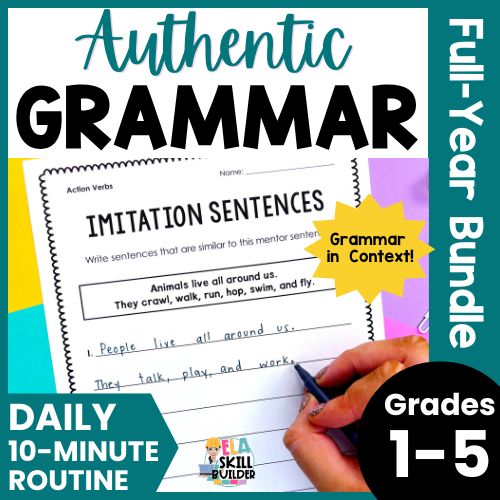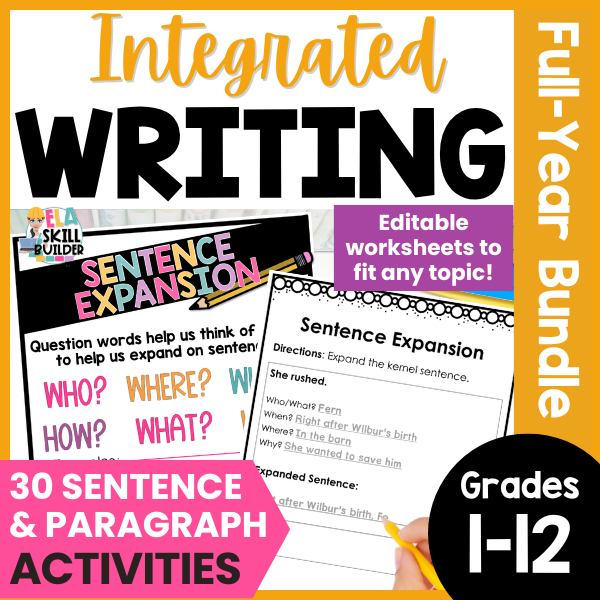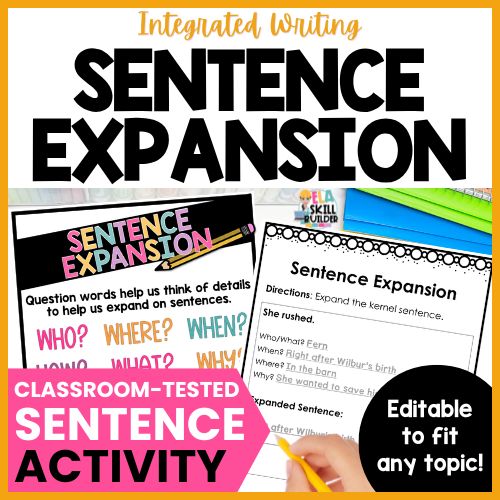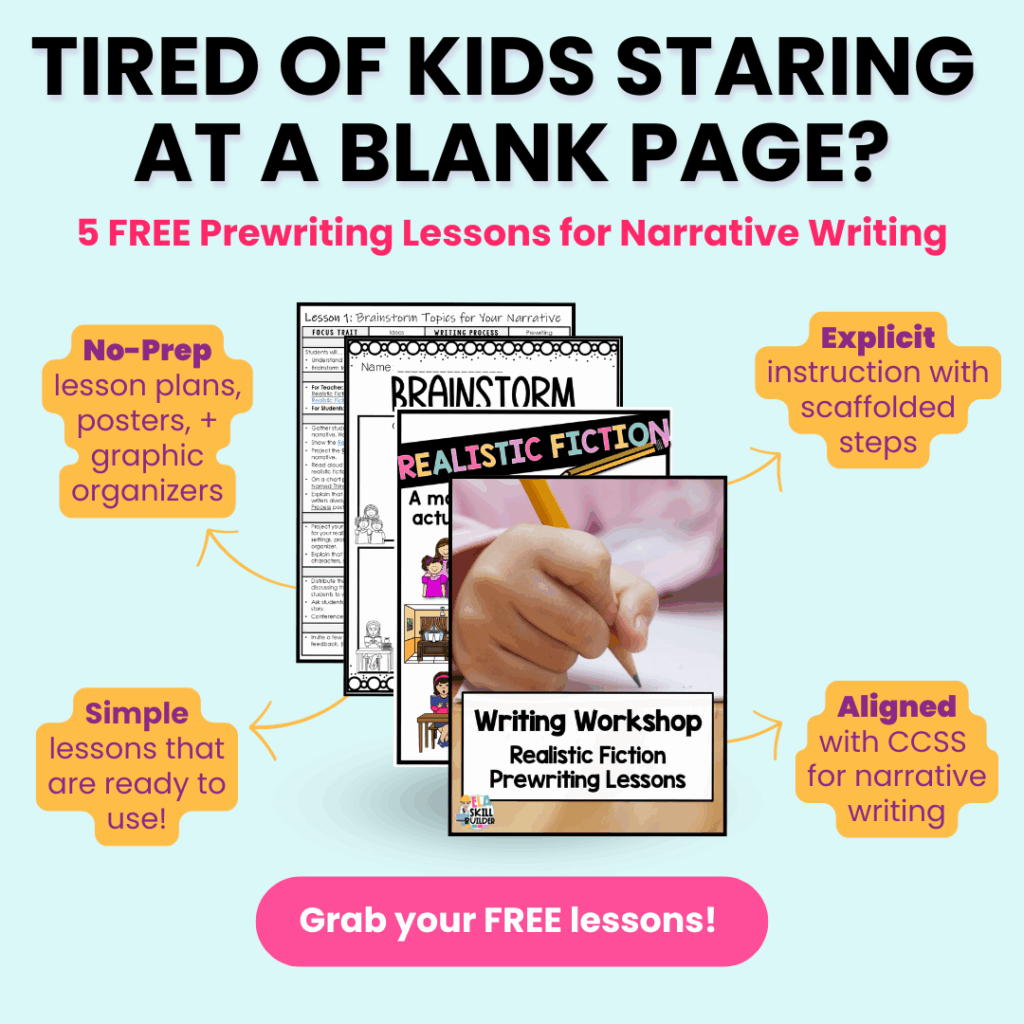

The 10-Minute-a-Day Grammar Routine That Actually Improves Student Writing
Are you frustrated that your students aren’t actually using the grammar skills that you’ve taught them?
You’re not alone. I used to spend so much time teaching grammar—fun songs, cute videos, engaging activities, workbook pages… you name it. And honestly, my students did great with all of it. They seemed to understand the grammar concepts really well.
But when it came time to write? Their papers were still filled with grammar mistakes.
That didn’t sit right with me. The goal of grammar instruction isn’t to just complete a worksheet correctly or pass a test – it’s to help students become stronger, clearer writers.
If you want to avoid the common pitfalls I fell into, check out my post on the 5 biggest mistakes I used to make teaching grammar.
So I dug into the research and discovered what many of us are missing: Grammar needs to be taught in the context of writing if we want students to actually apply what they’ve learned.
The good news? There’s a simple weekly routine – just 10 minutes a day – that makes teaching grammar in the context of writing super easy so students will actually use grammar in their writing. I’ll share exactly how it works in this post.
Before you get started, pick one grammar skill to focus on for the week. Then follow the routine below, which takes just 10 minutes a day and is proven to help students understand and apply grammar skills.
Before we dive into each day of the routine, take a look at this flowchart for a quick overview of the 10-minute-a-day weekly routine!
You can download your free copy of the weekly routine here to get started.

Day 1: Introduce the grammar skill with a mentor sentence
On Day 1 of the routine, you’ll introduce the targeted weekly grammar skill using a mentor sentence. A mentor sentence is a carefully selected sentence from real writing that shows how an author uses grammar and writing techniques to add clarity, detail, or meaning.
Why Mentor Sentences?
Mentor sentences help students see how grammar works in the context of actual writing – not just as a list of rules, but as tools real writers use to communicate effectively. Instead of starting with a definition or rule, students begin by noticing how the grammar skill shows up in writing that feels authentic and meaningful.
This inquiry-based approach is more engaging for students because it gives them a clear purpose for learning the grammar skill. They’re not just memorizing parts of speech or punctuation rules – they’re discovering how grammar can make writing stronger, more descriptive, and easier to understand. That sense of discovery motivates students to try out the skill in their own writing, which makes it stick.
👉 Want to dig deeper into why mentor sentences are essential for effective grammar instruction? Check out my full blog post here.
Steps for this mini-lesson:
- Read the mentor sentence:
Start by reading the mentor sentence aloud to the class. This sentence should clearly showcase the weekly grammar skill you’re focusing on. Then, read it together chorally with students to help them internalize the structure and rhythm of the sentence.- Example: Animals live all around us. They crawl, walk, run, hop, swim, and fly.
- Invite students to notice and share what stands out in the sentence:
Ask an open-ended question like, “What do you notice about this sentence?” Encourage students to comment on anything that stands out – grammar, word choice, punctuation, or structure. You can annotate their observations so everyone can see.- Example:“The author uses many action verbs to describe what animals do.”
- Discuss the Purpose:
Guide students to think about why the author used this grammar skill. Ask questions like, “How do these verbs help the writing?” or “What would the sentence be like without them?”- Example:“Action verbs help readers picture what’s happening by showing movement or activity.”
- Introduce a Focus Phrase:
Teach a short phrase students can repeat and remember all week. Write it down and say it aloud together.- Example: I used verbs to show action.

Day 2: Create an anchor chart to explain the grammar skill
On Day 2 of the grammar routine, you’ll build on what students discovered during the mentor sentence lesson. Now it’s time for direct instruction to clearly define the grammar skill and give students a tool they can return to again and again. Together, you’ll create an anchor chart that explains the skill using clear definitions, rules, and examples.
This explicit teaching helps solidify understanding – and when done after students have seen the skill in action, it’s much more effective and meaningful.
Why Grammar Anchor Charts
Anchor charts are powerful because they make learning visible. When you create a chart for each grammar skill you teach, you’re building a collection of go-to references that support student independence as they write. These charts serve as reminders of what students have learned and how to apply those skills in their writing. They also help reduce repeated questions and give students the confidence to self-check their work.
Rather than handing out a poster or pre-made rule sheet, building the chart with your students increases ownership, clarity, and retention.
Here’s how you can guide your students through this activity:
Steps for this mini-lesson:
- Create the Anchor Chart
Work with your students to create an anchor chart that summarizes the key terms, definitions, rules, and includes example sentences. - Model Example Sentences
Write a few example sentences together as a class to show how to use the grammar skill correctly in writing. - Display for Reference
Hang the anchor chart in the classroom so students can refer to it during writing and grammar activities.

Day 3: Practice the grammar skill with imitation sentences.
On Day 3 of the routine, students shift from noticing and discussing grammar to actually using it in their own writing. This is where the skill starts to stick. You’ll guide students in writing imitation sentences – sentences that mimic the structure and grammar of the mentor sentence from Day 1.
Writing imitation sentences gives students a chance to try the grammar skill in a structured, supported way. It’s focused, purposeful, and far more effective than isolated activities like correcting grammatical errors or sorting parts of speech.
Why Imitation Sentences?
Imitation sentences bridge the gap between understanding grammar skills and using them in writing. Instead of practicing grammar in isolation on a worksheet, students practice applying it in complete, thoughtful sentences that resemble real writing.
Because students are working from a clear model, they’re more likely to use the skill correctly. This kind of guided practice also builds writing confidence and helps students transfer grammar skills into their independent work. It’s a simple shift, but one that makes a big difference.
Here’s how you can guide your students through this activity:
Steps for this mini-lesson:
- Review the mentor sentence: Start by revisiting the mentor sentence from Day 1
- Example: Animals live all around us. They crawl, walk, run, hop, swim, and fly.
- Write a Class Imitation Sentence: Work together with your students to create a sentence that imitates the mentor sentence’s structure and grammar skill.
- Example: Puppies live all around us. They bark, jump, and lick.
- Independent or Partner Practice: Invite students to write their own imitation sentences either independently or with a partner.
- Example: Kittens roam everywhere. They pounce, climb, and nap.
- Share and Celebrate: Have students share their sentences with the class or in pairs, and encourage positive feedback focused on correct use of the grammar skill.

Day 4: Reinforce the grammar skill with engaging activities.
On day 4 of the grammar routine, it’s time to reinforce the grammar skill with more focused, drill-like practice. After students have been introduced to the skill and practiced it in context through mentor and imitation sentences, this kind of repetitive practice helps solidify their understanding, makes the rules stick, and builds automaticity.
These activities can be assigned during your writing instruction, but they also work great as a center activity or take-home work for extra practice.
Here are some effective examples of isolated grammar activities you can use on Day 4:
- Grammar Boom Cards: These digital, self-checking decks are a favorite because they require no prep and provide immediate feedback, making practice interactive and effective.
- Grammar scavenger hunt: Have students search for the targeted grammar skill in their independent reading books or classroom texts. This builds awareness and shows students that grammar skills are everywhere.
- Grammar task cards: Use cards with sentences or questions that focus on the grammar skill. Students can work independently or in pairs to answer or correct them.
- Grammar bingo: Create bingo cards featuring the grammar skill (like parts of speech or punctuation marks). This adds a game element that motivates students while reinforcing concepts.
- Sorts: Provide sorting activities where students categorize words or sentences by grammar features (such as sorting proper nouns vs. common nouns). This hands-on practice helps deepen understanding.
- Fill-in-the-blank worksheets: Students complete sentences using the targeted grammar skill.
- Sentence correction activities: Students identify and fix errors focused on the skill.
- Matching games: Match grammar terms with definitions or examples.
- Interactive whiteboard games: Use apps or slides where students drag and drop words or punctuation to build correct sentences.
Steps for this mini-lesson:
- Choose a reinforcement activity: Find a supplemental activity like a worksheet, station game, or Boom Cards deck that targets the grammar skill.
- Explain the activity to students: Briefly go over the instructions and the purpose of the activity to make sure students know what to do.
- Monitor and support: Circulate around the room to help students as needed and keep them focused on applying the grammar skill correctly.
- Review and reflect: Wrap up by discussing the activity and reinforcing the grammar skill, highlighting how it helps their writing.

Day 5: Revise for the Skill in Student Writing
By Day 5 of the grammar routine, students have been introduced to the grammar skill with a mentor sentence, learned the definitions and rules through an anchor chart, practiced with imitation sentences, and reinforced the skill with drill-like activities. Now, it’s time to bring it all together by applying the skill directly in their own writing.
This step is key to helping students transfer grammar knowledge into real writing situations. Without this final step, grammar can remain something students do during grammar time – but not something they apply meaningfully as writers. Revising for the grammar skill gives students a chance to reflect on their work and strengthen it using what they’ve learned.
Why Revise?
Many students think revision is just fixing spelling or punctuation errors, but grammar-focused revision goes deeper. It teaches them to improve meaning and clarity by intentionally using the grammar skill they’ve just practiced, helping their writing become stronger and more precise.
Research shows that young writers benefit most from targeted revision – where they’re asked to focus on one specific goal at a time. Giving students a clear skill to revise for keeps the task manageable and purposeful. When you show them how grammar makes their writing stronger, they’re more likely to value it and use it independently in future pieces.
Steps for this mini-lesson:
- Distribute a Revising Checklist:
Provide students with a revising checklist focused solely on the grammar skill you’ve been teaching that week. This helps them zero in on one skill at a time instead of feeling overwhelmed by all aspects of revision. - Model Using the Checklist:
Demonstrate how to revise a sample piece of writing—either your own or a student’s—using the checklist. Talk through your thought process, showing exactly how you identify errors or missed opportunities for the targeted grammar skill and how you fix them. - Students Revise Their Own Writing:
Have students use the same checklist to revise their own writing. This can be a current piece they are working on, and it doesn’t have to be finished. The key is focused revision on one grammar skill at a time. - Share and Discuss Revisions:
Invite students to share the revisions and edits they made. Celebrate their improvements and discuss how using the checklist and focusing on one skill at a time makes their writing clearer and stronger.
This scaffolding ensures students don’t just apply the skill blindly but learn to identify it and revise purposefully. It also makes revision manageable, which research shows is key for young writers.

Day 5 (or Later): Authentic Assessment of Grammar Skills
After you’ve introduced, practiced, and revised the grammar skill through the 10-minute routine, it’s crucial to check if students can actually use that skill in their own writing. This is where authentic assessment comes in. Unlike typical multiple-choice quizzes or worksheets where students just identify or correct errors, an authentic assessment asks students to apply the grammar skill in a real writing task. This approach aligns with the ultimate goal of grammar instruction: helping students become clearer, stronger writers.
Why Choose Authentic Assessment?
Traditional grammar tests can tell you if students recognize a skill, but they don’t show if students can use it meaningfully in their writing. Authentic assessments provide a clearer picture of how well students transfer the skill to their own work. It’s the difference between knowing the rules and actually using them to communicate better.
Steps for this mini-lesson:
- Create a writing prompt that requires the targeted grammar skill:
Design a prompt that encourages students to write a short paragraph or three sentences where they naturally use the grammar skill. For example, if you’ve been focusing on proper nouns, the prompt might ask students to write about their favorite place or person, prompting them to include specific names. - Develop a rubric focused on the grammar skill:
Make a simple rubric highlighting the grammar skill you’re assessing. This might include criteria like “3 sentences with beginning capitals” and “Each sentence has an action verb.” Sharing this rubric with students helps them understand what’s expected. - Invite students to self-assess:
Encourage students to use the rubric to review their own writing before you collect it. This builds their awareness of grammar and ownership of their learning. - Grade the assessments and plan next steps:
When you review the assessments, look for patterns in who is applying the skill well and who might need reteaching or more practice. This informs your instruction moving forward and ensures that all students get the support they need to improve.

Grab it: 5-Day Grammar Routine
Ready to help your students actually use grammar in their writing?
Grab this free, classroom-tested 5-day grammar routine! It includes a simple lesson plan template you can use with any grammar skill – and it only takes 10 minutes a day.
Download it now and start seeing the difference in your students’ writing!
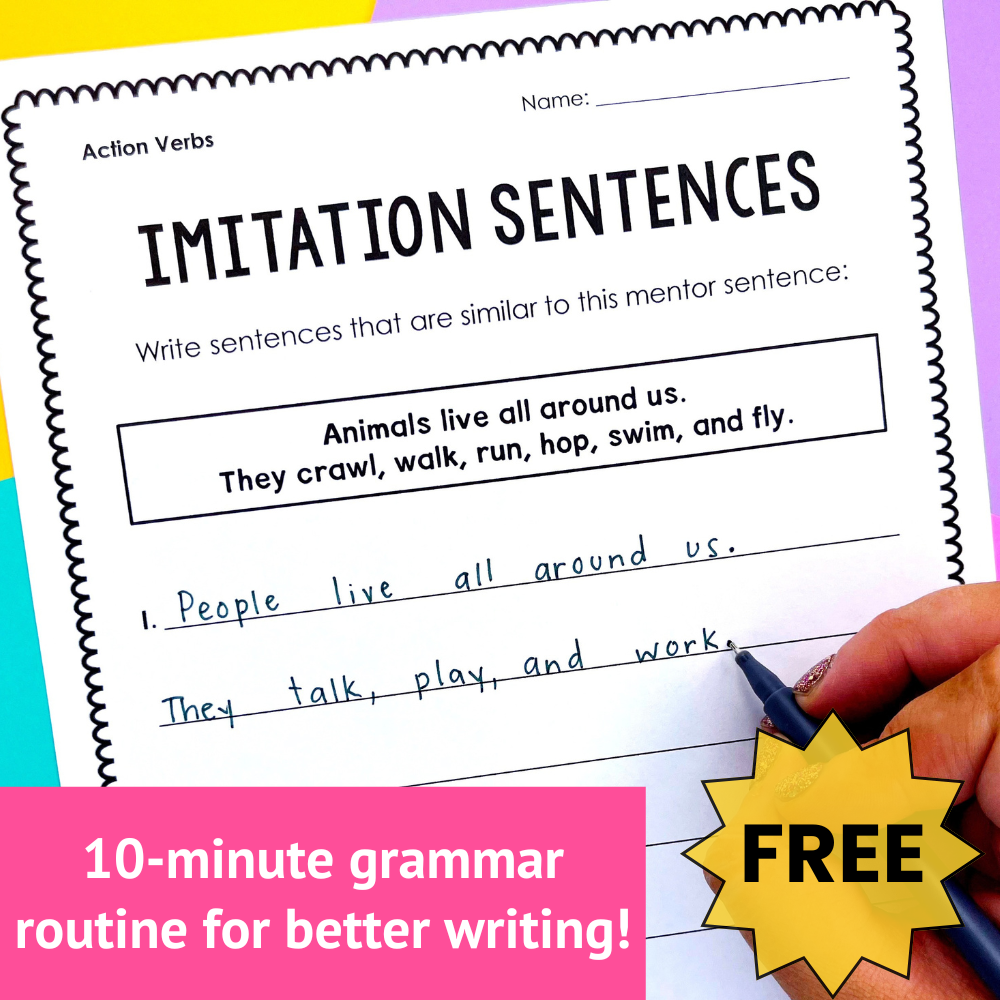
Conclusion
I’ve seen so many teachers try this 5-day grammar routine and watch their students actually start using grammar skills in their writing – not just on worksheets, but in real, meaningful ways.
It’s amazing how just 10 minutes a day, focused on clear, purposeful practice, can make such a big difference. If you’ve been frustrated by grammar instruction that doesn’t stick, this routine could be exactly what you need to simplify your teaching and boost your students’ confidence as writers. Give it a try, and I’d love to hear how it goes!
About Jen Goasdone
Jen Goasdone, the owner of ELA Skill Builder, is a dedicated educator committed to empowering teachers with simple, research-based strategies for effective writing instruction. With a focus on making ELA teaching easier and more impactful, Jen helps students build a strong writing foundation that will serve them for years to come. Passionate about both teacher and student success, she strives to make writing instruction enjoyable and effective for elementary students.


Hey Teachers,
I'm Jen from
ELA Skill Builder!
My mission is to empower elementary teachers like you with the tools and confidence to teach writing effectively, so your students can grow into strong, capable writers.
Best Sellers!
Writing resources
Features explicit writing workshop lessons for narrative, informational, and opinion writing.
Grammar resources
Features a simple weekly routine that teaches grammar in context in just 10 minutes a day.
writing prompts
Features 810 prompts designed to strengthen paragraph writing skills all year long!
cross-curricular writing
Features 30 sentence and paragraph activities inspired by The Writing Revolution that fit any subject.
coupon code
Get 15% off Your First Purchase
free lessons!
Grab 5 free prewriting lessons to kick off your narrative writing unit – all materials included!
jOIN A COMMUNITY
writing training
Features 4 hours of video lessons designed to help you run a structured, effective, and engaging writing block.
free gramamr routine!
Features a free 5-day routine for teaching any grammar skill in context, in just 10 minutes a day!
free SENTENCE ACTIVITY
Features a free, editable sentence activity that helps students expand sentences for any topic.
contact jen!
Got questions? Fill out this contact form, and I’ll get back to you as soon as possible.



